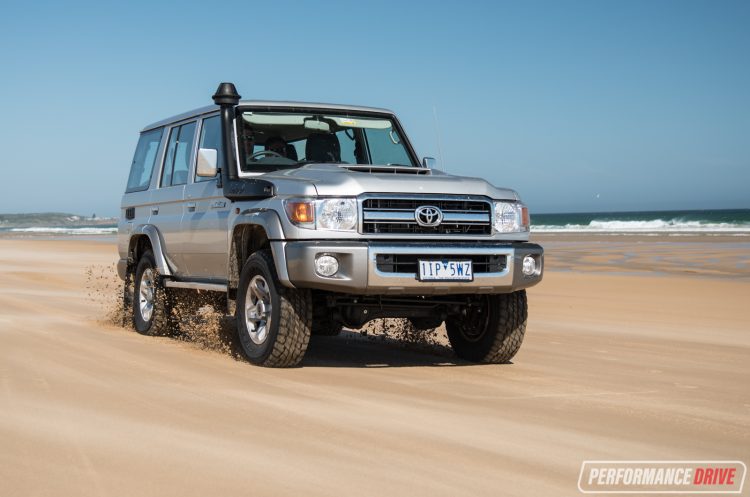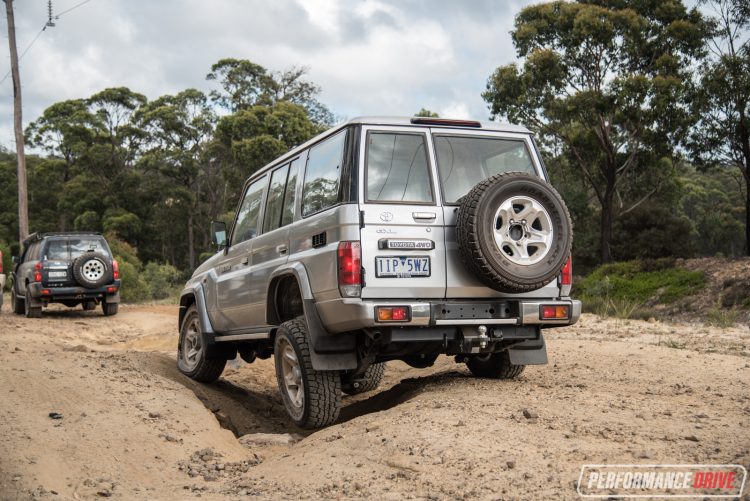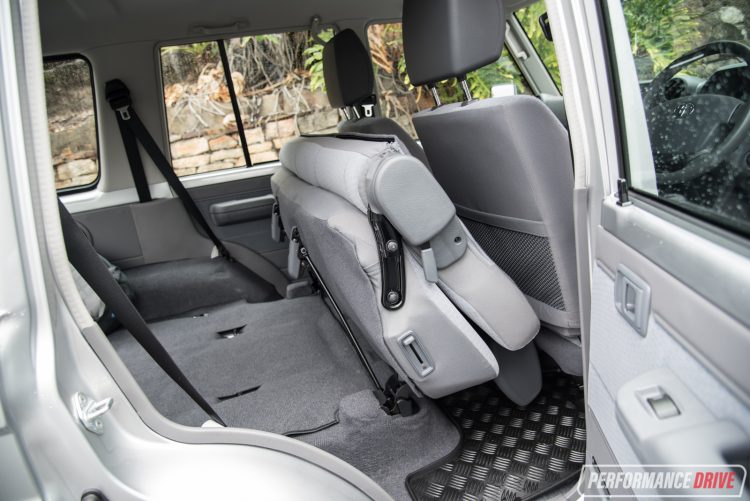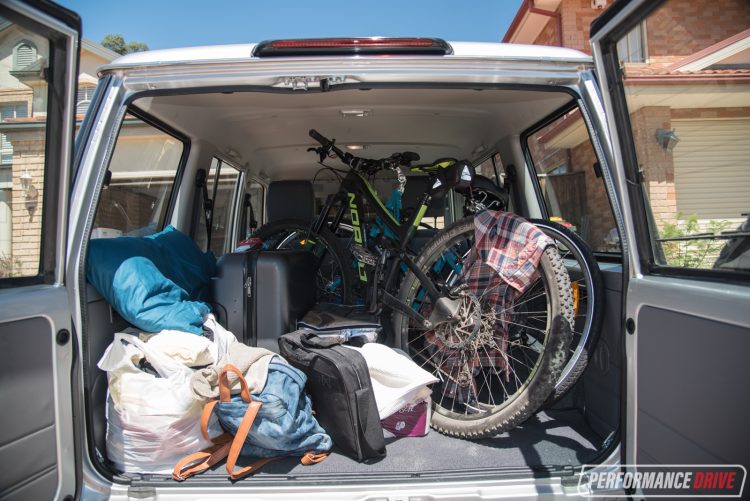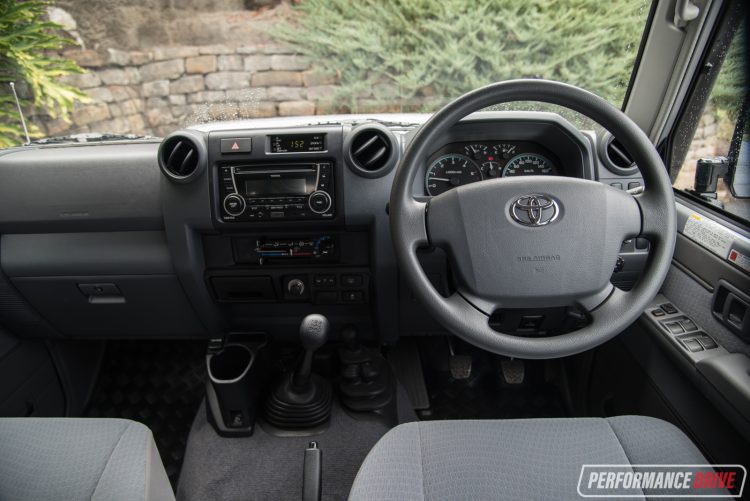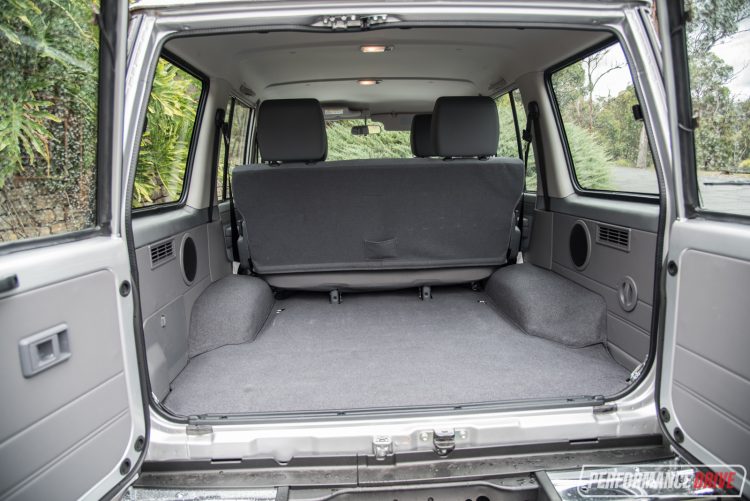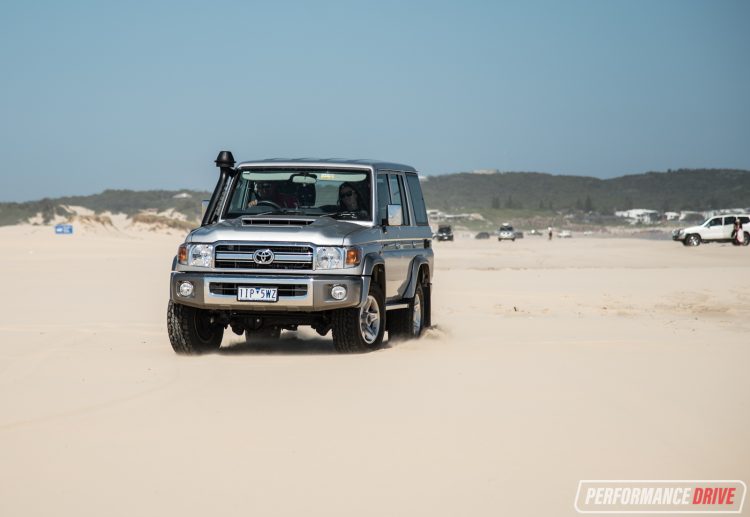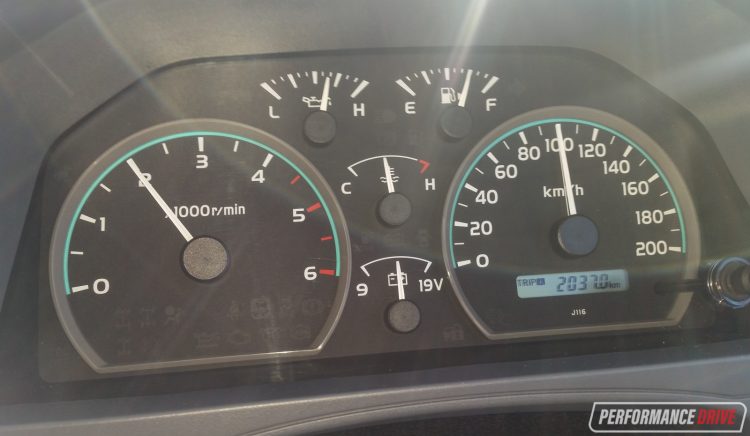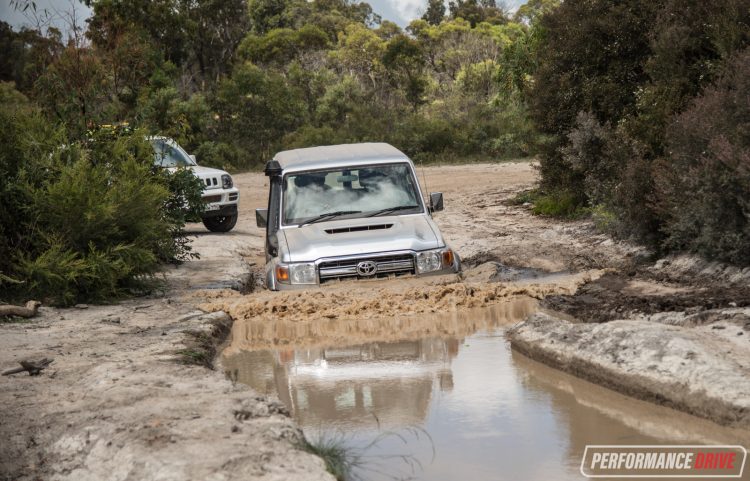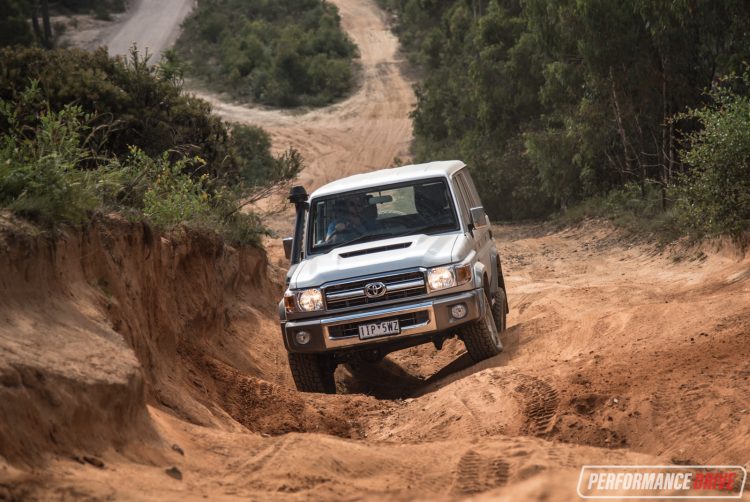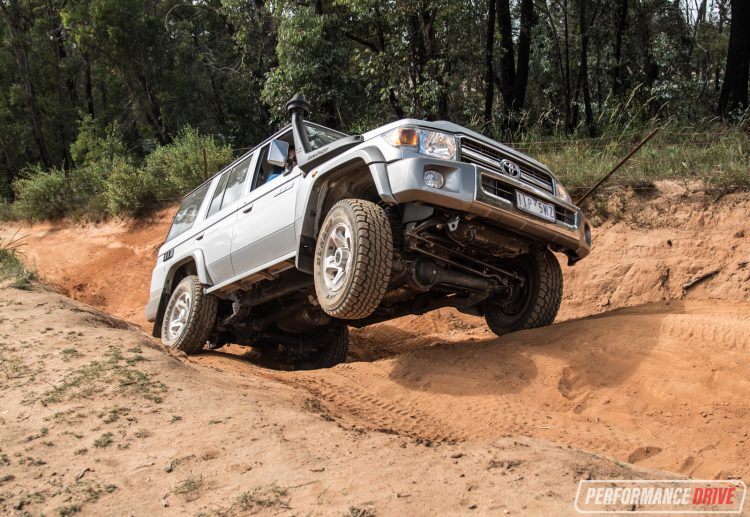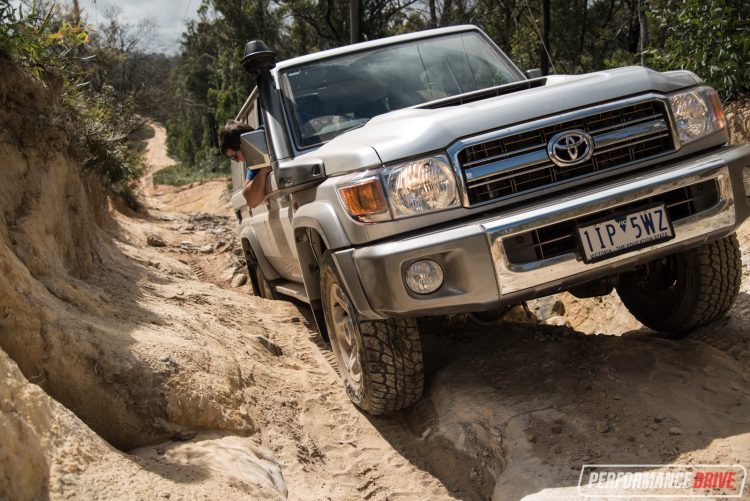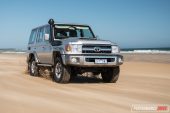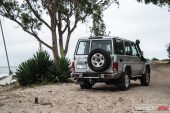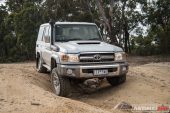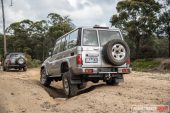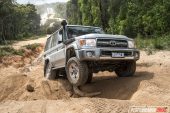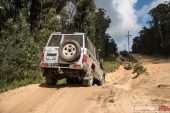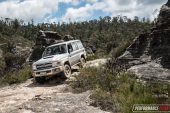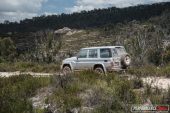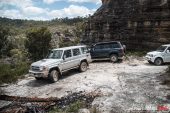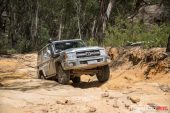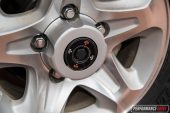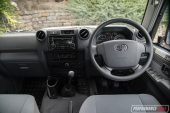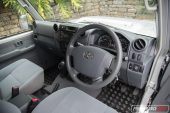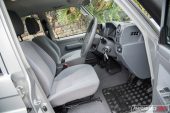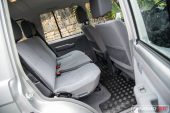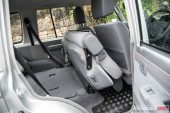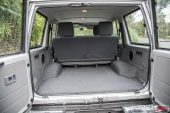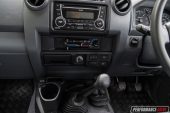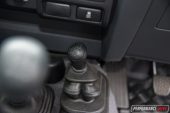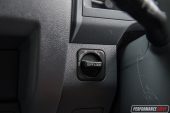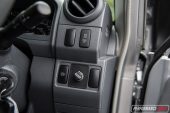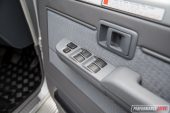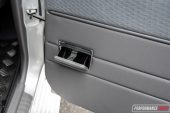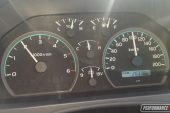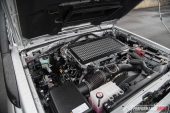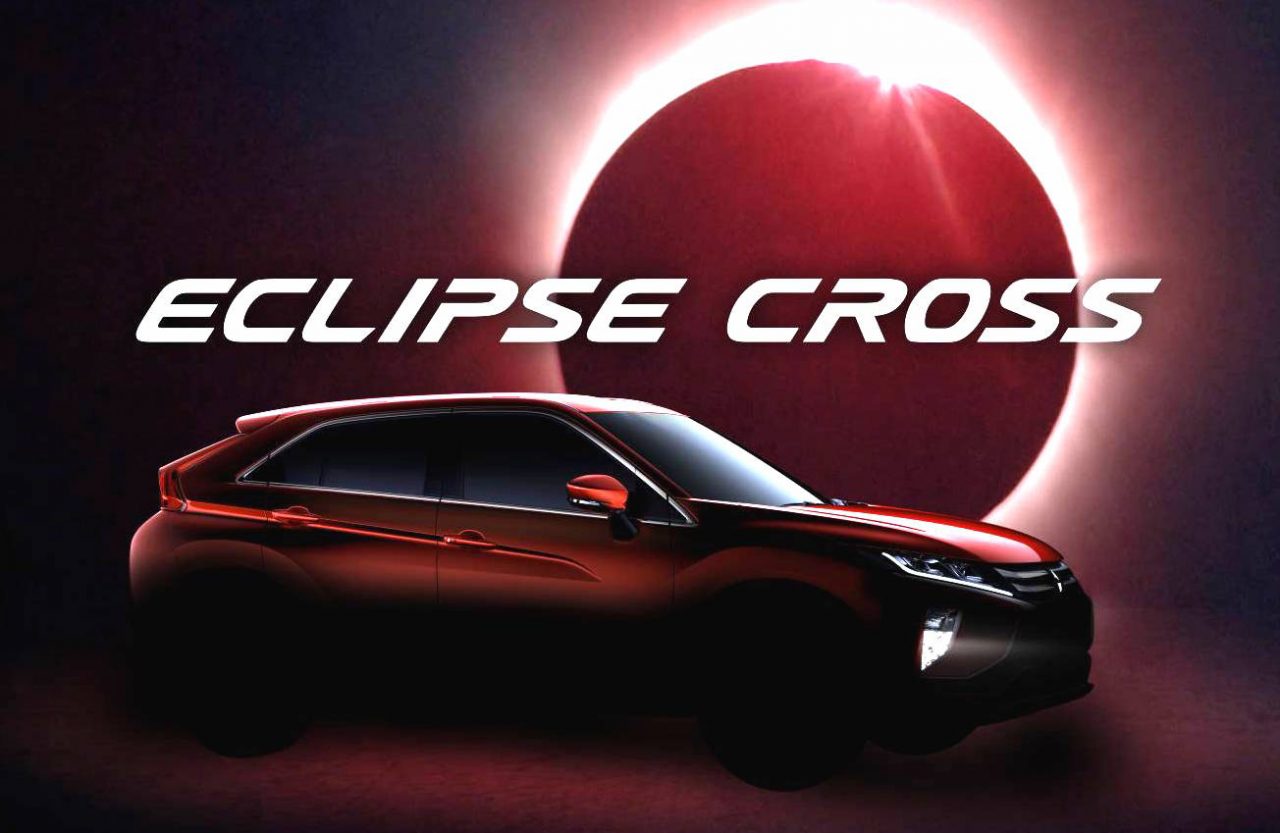Built for purpose. Rugged. Capable. Heavy-duty. Matured. These are all phrases that quickly sum up the 2017 Toyota LandCruiser GXL 70 Series wagon. If you’re shopping for a proper off-road vehicle, you’ve come to the right place. If you want to prance around town and appear as though you go ‘adventuring’ every other weekend with your jet-ski, head over to the dual-cab ute market. You don’t belong here. This is a genuine workhorse designed for the heaviest of duties.
Firstly, yes. This is a brand new vehicle. Toyota Australia still sells the 70 Series ‘Cruiser due to demand from outback and rural buyers and hardcore 4×4 enthusiasts. Make no mistake though, this is quite an old vehicle. There are very few creature comforts inside and the exterior design certainly isn’t aerodynamic – it’d probably break a wind tunnel if it were ever tested for its drag co-efficient.
For the 2017 model Toyota Australia has made some crucial changes to the big beast. Devised in conjunction with over 100,000km in local testing, it has updated the industrial-strength 4.5-litre turbo-diesel V8, extended second and fifth gear ratios, and improved safety for the single-cab ute version. Speaking of which, Toyota continues to offer four body styles (single-cab, double-cab, wagon, and troop carrier) in two variant levels (WorkMate and GXL). The single-cab is also available in GX trim.
Prices have increased for the updated range, soaring by up to $5500 in the case of the now five-star ANCAP-rated single-cab ute version. This GXL wagon we’re testing here is priced from $64,990, which is up $4000 from the pre-updated model.
2017 Toyota LandCruiser 70 Series GXL wagon – THE SPECS
[column width=”47%” padding=”6%”]Engine: 4.5-litre turbo-diesel V8
Output: 151kW@3400rpm / 430Nm@1200-3200rpm
Transmission: Five-speed manual
Drive type: Part-time four-wheel drive, locking front & rear diffs
Wheels: F & R: 16×7.0, 265/70
ANCAP: Not tested (ute 5 stars)
Kerb weight: 2265kg
Power-to-weight: 14.47:1 (kg:kW)
Official fuel economy: 10.7L/100km[/column] [column width=”47%” padding=”0″]Economy during test: 11.5L/100km
Fuel capacity/Type: 130L/Diesel
Power efficiency: 12.68kW:L/100km
0-60km/h: 5.34 seconds*
0-100km/h: 13.82 seconds*
1/8 mile: 12.36 seconds at 95.5km/h*
1/4 mile: 19.10 seconds at 119.8km/h*
100-0km/h braking: 3.55 seconds at 41.08 metres*
Decibel at idle: 59*
Peak decibel at 60-100km/h: 85*
Priced from: $64,990[/column][end_columns]
* Figures as tested by PerformanceDrive on the day. Factory claims may be different
2017 Toyota LandCruiser 70 Series GXL wagon – THE PACKAGE
There isn’t much included in ‘the package’. Air-conditioning is a $2761 option, and it’s not climate control. There is a neat little air-con power adjuster though, so you can turn up or down the amount of work you want the compressor to do. Power windows are standard on all windows (auto for driver only), and there is only one cup-holder in the entire cabin – for the only person that matters we guess; the driver. Interestingly, rear passengers are treated to their own ashtrays – a sign of the vehicle’s age – and the large exterior mirrors require manual adjustment.
As for cabin space, it’s not actually as big as it looks from the outside. Legroom is adequate in the back however and due to its tall ceiling headroom is also fine, but the cabin is pretty narrow by today’s large SUV standards. Fortunately, the doors and pillars, in big contrast to today’s vehicles, are quite thin and narrow, so it’s a very clean and uncluttered design in here. The seats are mounted high, giving you a definite high-riding position. Poke your head under the rear bench and you’ll see the floor is completely flat. This allows for a flat loading space when you fold together the rear bench and flip it up right out of the way. When you do this you open up heaps of space, easily enough to swallow… well, in our case, two push bikes (with wheels left on) and a week’s worth of luggage – you could probably neaten it up and get four or five bikes in.
Front seat space is abundant with a decent-sized centre console. It’s difficult to actually use the console armrest as it’s too low, and the space in front of it, in between the gear levers is just wasted with carpet. We think Toyota could have installed a plastic tray here fairly easily so you have somewhere to put your phone and/or some additional cup-holders, especially for this top-spec GXL version. We also think the cabin deserves a dedicated mounting position for a CB radio.
Sitting inside is a fun experience nonetheless, and for some reason it makes you smile uncontrollably (well, it did for us), as it reminds you of the good ol’ days. It’s also very cool because it can make you feel like you’re sitting in an immaculately restored classic. The long gear shifter stems from the floor, and the windows are pancake flat, and the view outside is refreshingly clear and unobstructed. The media unit, if you’re wondering, offers Bluetooth connectivity (and music streaming capability) with USB support, cranking tunes through a laughably basic four-speaker stereo. But hey, at least you get an electric aerial to play with – how many SUVs on the market offer that?
You might have read that some dual-cab utes offer a 3500kg towing capacity. This figure alone is a bit of a misleading ploy by some manufacturers, as the gross combination mass (GCM) is what matters most. For example, you can tow 3500kg (braked) in the latest Ford Ranger Wildtrak dual-cab, however, the GCM is restricted to 6000kg. That means if you are towing close to 3500kg worth of trailer load, you don’t have much permissible mass left over for the tray area or even the cabin (Wildtrak manual dual-cab: 2250kg kerb weight + 3500kg braked towing = 5750kg, 250kg remaining for passengers and tray cargo [auto is worse]). In this scenario, it would be illegal to tow 3500kg and have three or more 85kg-plus adult passengers on board, with absolutely nothing in the tray.
The LandCruiser 70 Series dual-cab on the other hand is able to tow 3500kg as well (braked), but it’s GCM is 6800kg (6900kg for single-cab, 6560kg for wagon). This means you can tow a 3500kg caravan and pack the tray/cargo area/cabin with another tonne worth of stuff (dual-cab manual; 2175kg kerb weight + 3500kg braked towing = 5675kg, 1125kg remaining for passengers and tray cargo). As we suggested at the beginning, the 70 Series is not a show pony toy Tonka truck; it’s a purpose-built, heavy-duty utility device designed for serious applications.
Part of this heavy-weight carrying capacity is thanks to it’s large 4.5-litre V8 engine that provides very effective compression braking, while four-piston front and single floating-piston rear brakes clamping 322m front and 312mm discs give you a substantial safety buffer in emergencies. Across our usual 100-0km/h braking test the wagon pulled up in 41.08 metres, bettering the 46.99m we achieved in the single-cab model last year. We’re guessing the improvement is down to the weight distribution of the wagon, along with the heavier weight of the wagon that may have helped the off-road-ready Dunlop Grandtrek 265/70 tyres bite harder onto the tarmac.
2017 Toyota LandCruiser 70 Series GXL wagon – THE DRIVE
Like the package and cabin practicality, it’s immediately obvious only after a short drive that the LC70 is a heavy-duty tool. The steering is pretty heavy and all driver controls require bold action to operate. We wouldn’t call the clutch feel heavy but it will be heavy if you’ve just stepped out of a four-cylinder ute or a family SUV/crossover. You’ll also instantly notice the steering rack feels like it has been around since the 1980s, showcasing plenty of on-centre play. This is a good thing though as it helps to have a slackened steering response when you’re off-roading.
Okay, so onto the most important element to the 2017 update; the powertrain revisions. Toyota has implemented piezo-electric diesel injectors that claim to provide better low-end response and a more complete combustion, according to the manufacturer. We can confirm these alone have made a noticeable improvement over the 2016 model’s engine. The V8 revs more freely and sounds slightly more refined when doing so. Our decibel gauge measured 85dB during acceleration compared with 87dB before. Idle is slightly louder though, jumping from 50dB to 59dB, potentially due to a bigger/more complete explosion with each engine revolution. Although, the difference is not as obvious at idle compared with when revving.
These injectors also help to reduce fuel consumption, with the official average now standing at 10.7L/100km, down from 11.9L. This, again, is noticeable in the real world as we returned an average of about 11.5L/100km during our test compared with 12L/100km we returned in the lighter-weight (2265kg versus 2075kg) single-cab model last year. Toyota says emissions are also reduced thanks to the installation of a diesel particulate filter. The filter requires flushing via a button on the dash every now and then. It’s a good idea to drive the vehicle across a decent distance once a week to allow the engine and filter system to heat right up to its optimal running temperature, as the filter works more effectively with heat.
The second major powertrain upgrade is the extension of second and fifth gear ratios for the five-speed manual (no auto option available). Second gear is almost seven per cent taller, at 2.294:1, capable of nudging 70km/h. From our test drive we were able to see a huge benefit from this. First gear is still very short, at 4.529:1, so it can be tiring in stop-start traffic conditions, but at least now second gear will take you up to traffic speeds whereas before you’d have to change up to third. Third and fourth gear remain the same (1.490:1 and 1.000:1). As for fifth gear, it’s almost 15 per cent taller than before, at 0:750:1, and this helps out massively on the highway. The engine now requires a more relaxed 2000rpm to maintain 100km/h, compared with 2500rpm in the old setup. The front and rear diff ratios remain unchanged, at 3.90:1.
Although all of this might seem like a bunch of abstract numbers and specs changes, they make a big difference in the real world. Whether it’s driving through the inner suburbs and in slow traffic, or out on the freeway, the changes to the engine and transmission definitely improve this big beast’s overall useability and practicality. The engine now hums along with a clearer V8 burble compared with the uneven racket of the previous tune, and the gear ratios make it a lot more pleasant than before. The torque of the engine doesn’t seem phased when in the overdrive fifth and travelling up long hills either, although straight-drive fourth is sometimes required if you don’t have enough speed behind you.
One thing we did find is that you can no longer take off in second gear. Well, you can if you dial up the revs and very slowly release the clutch. Previously, you could take off in second with pretty much no hesitation. The aforementioned benefits easily outweigh this potential deficit though, because so long as you’re rolling, even at 5km/h, that longer second gear has brilliant pulling power. As before, the V8 produces 151kW at 3400rpm. Peak torque of 430Nm is available through 1200-3200rpm, so you can continue to enjoy the surging ability. There’s no doubt, the updates have improved the LC70’s on-road driveability and comfort significantly.
As for the performance, we timed 0-100km/h in 13.82 seconds, bettering our time we achieved in the lighter-weight single-cab version with the previous gear ratio and engine tune (14.85 seconds). We put the improvement down to the freer-revving engine in the update, and the altered second gear ratio which is now able to build more speed before shifting to third. Going from dual fuel tanks to a single tank would also save some weight in the single-cab, so we suspect that variant would be even swifter now (the wagon continues with a single 130L tank, as before).
As for off road, we’ll start by saying this very clear statement; it is the best off-road production vehicle we have ever tested. During our rigorous test with two highly modified Nissan Patrols, a modified Toyota LandCruiser 100 Series (with over 500,000km on the clock), and a Suzuki Jimny tagging along, it was simply unstoppable.
There is no real weak point, and even the standard tyres are very good. As standard there are front and rear diff locks, which help make it ridiculously relentless over very uneven ground and up very steep and stepped climbs. Sure, the suspension travel and potential flex isn’t quite as good as, say, a Jeep Wrangler Rubicon with its detachable sway bars, but it more than makes up for it with sheer torque, ground clearance, and traction. Even though we were tripoding a lot, it didn’t seem to interrupt forward progress at all.
Ground clearance is rated at 235mm, with a 33-degree approach angle and 23-degree departure angle on this wagon variant. Water wading depth is 700mm, and all models come with an engine snorkel as standard. Also standard are some impressively robust, high-mounted aluminium side steps. These can take some light scrubs and bumps without folding like some factory steps out there. Serious off-road enthusiasts will be looking to swap to rock-sliders anyway. Speaking of which, the ground clearance is impressive but if take a look underneath you’ll see there isn’t much hanging down to be snagged. The transfer case gets its own ski-tipped skid plate, while the exhaust and drive shaft are mounted up nice and high.
For a standard, factory-fresh production vehicle, the LandCruiser 70 Series is the ultimate five-seat, all-terrain-conquering machine. And best of all, it’s a Toyota which means it has been developed with literally decades of experience behind it. It goes without saying, it’s now our favourite off-road vehicle.
2017 Toyota LandCruiser 70 Series GXL wagon – THE VIDEO
2017 Toyota LandCruiser 70 Series GXL wagon – THE VERDICT
The 2017 Toyota LandCruiser 70 Series GXL wagon is a machine of a vehicle. We absolutely love it. The sheer rawness yet genuine capability of it is refreshing in today’s pretend SUV market, and the revised powertrain makes it a more friendly and comfortable, country-circumnavigating beast. You may have heard the term ‘dream car garage’, which is basically an imaginary garage that can be filled with a handful of your favourite vehicles, with no restriction on price or rareness. This GXL wagon is right in there for us, even in the top five.
[column width=”47%” padding=”6%”]PROS:
– Greatest off-road ability and toughness we’ve ever experienced
– Revised V8 turbo-diesel noticeably more refined
– Extended 2nd and 5th gear ratios help a lot
– Charmingly basic cabin
– Locking front and rear diffs, live axle front end
– Towing capacity and gross combination mass
– Bullet-proof Toyota dependability at its best
– Cool, retro appeal? Collectable?
[/column] [column width=”47%” padding=”0″]CONS:
– Heavy-duty nature won’t appeal to all
– Wagon not ANCAP tested (likely below 4 stars)
– Price
– 130L single fuel tank replaces dual 90L tanks in single-cab (wagon sticks with single 130L as before)[/column][end_columns]
As always, if you’re thinking about buying a new car don’t forget to click here to speak with our car buying specialists.
